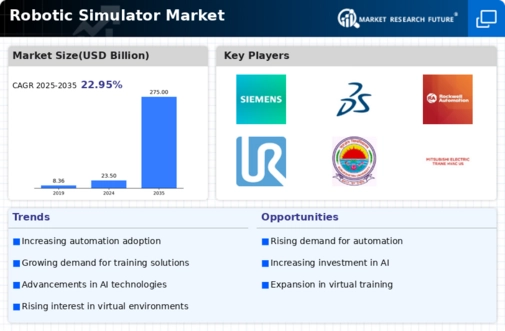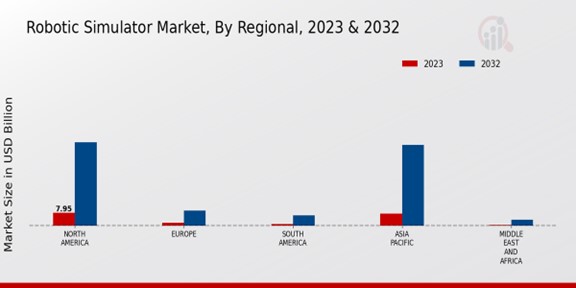Increasing Demand for Automation
The Global Robotic Simulator Market Industry experiences heightened demand for automation across various sectors, including manufacturing, healthcare, and logistics. As industries strive for efficiency and cost reduction, robotic simulators provide a platform for testing and optimizing robotic systems before deployment. This trend is evidenced by the projected market value of 23.5 USD Billion in 2024, indicating a robust growth trajectory. Companies are increasingly investing in robotic simulation technologies to enhance productivity and reduce operational risks, thereby driving the market forward. The ability to simulate complex environments allows for better training and preparation, which is crucial in today's fast-paced industrial landscape.
Advancements in Robotics Technology
Technological advancements play a pivotal role in shaping the Global Robotic Simulator Market Industry. Innovations in artificial intelligence, machine learning, and sensor technologies enhance the capabilities of robotic systems. These advancements enable more sophisticated simulations that can accurately replicate real-world scenarios, thus improving the training and development processes. As a result, organizations are more inclined to adopt robotic simulators to stay competitive. The market is expected to witness a remarkable growth rate, with projections indicating a value of 275.0 USD Billion by 2035. This growth reflects the increasing reliance on advanced robotics across various applications, further solidifying the importance of simulation in the development lifecycle.
Chart Representation of Market Growth
The Global Robotic Simulator Market Industry is characterized by a remarkable growth trajectory, with projections indicating a market value of 23.5 USD Billion in 2024 and an anticipated surge to 275.0 USD Billion by 2035. The compound annual growth rate (CAGR) for the period from 2025 to 2035 is estimated at 25.06%. This growth is driven by various factors, including advancements in technology, increasing demand for automation, and the need for enhanced safety measures. The following chart illustrates the projected growth of the market over the specified period, highlighting the significant upward trend in the adoption of robotic simulation technologies.
Educational and Training Applications
The educational sector is significantly contributing to the expansion of the Global Robotic Simulator Market Industry. Institutions are increasingly incorporating robotic simulators into their curricula to provide students with hands-on experience in robotics and automation. This trend is fostering a new generation of skilled professionals equipped with the necessary competencies to thrive in the evolving job market. The integration of simulation technologies in training programs enhances learning outcomes by allowing students to experiment and innovate in a risk-free environment. As educational institutions recognize the value of these tools, the demand for robotic simulators is expected to grow, further propelling market dynamics.
Growing Focus on Safety and Risk Management
Safety and risk management considerations are becoming increasingly critical within the Global Robotic Simulator Market Industry. Organizations are recognizing the necessity of ensuring that robotic systems operate safely in dynamic environments. Robotic simulators allow for the identification and mitigation of potential hazards before actual deployment, thereby reducing the likelihood of accidents. This proactive approach to safety is driving investments in simulation technologies. As industries prioritize worker safety and compliance with regulations, the demand for robotic simulators is expected to rise. This trend aligns with the overall market growth, as companies seek to enhance their safety protocols through effective simulation practices.
























Leave a Comment